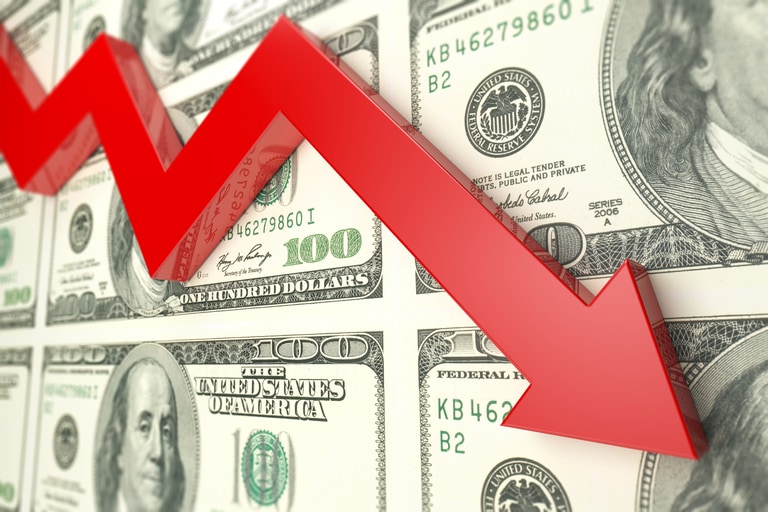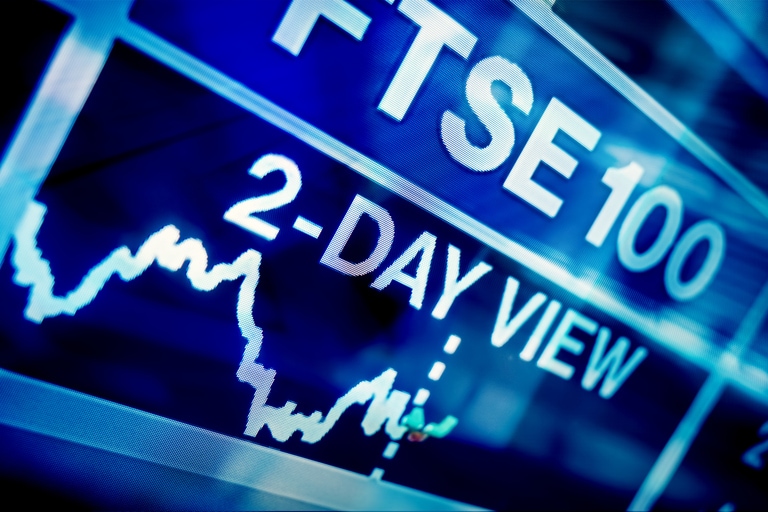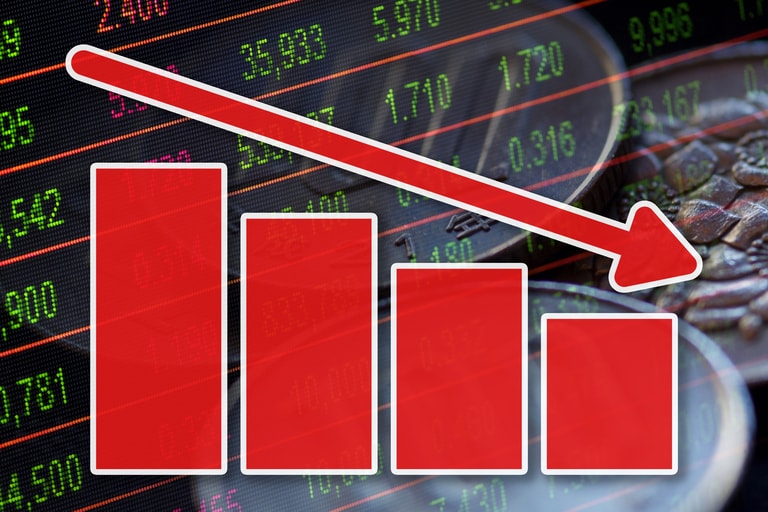After yesterday’s sharp declines in the US, European markets have followed suit, falling back sharply across the board, although the FTSE100 has outperformed with this afternoon’s sterling weakness appearing to offer a degree of support.
Europe
Amongst today’s gainers Sainsbury’s shares have moved higher after reporting a solid set of H1 results, while acknowledging that households were feeling the pinch on every level. Earlier this week the supermarket announced it was hiring another 18,000 people over the Christmas period.
Total grocery sales rose 0.2% in H1, with all the gain coming in Q2, which saw sales rise by 3.8%. When general merchandise is included, the picture is less bright, with declines in Argos and Sainsbury GM and clothing. This was offset by a big increase in fuel sales. Total retail excluding fuel saw a decline of -1.3%, and including fuel, an increase of 4.4%.
Sainsbury has said it is halfway through a £1.3bn cost saving program with management keeping full year profit guidance unchanged at between £630m and £690m.
Harbour Energy is also having a good day despite having to absorb a heavier tax burden due to the energy profits levy. It also appears to be on course to hit and possibly beat its full year revenue target of $5.18bn.
Today’s trading update for the year to date has seen revenues rise to $4.1bn, while its tax liability for the current year is expected to by $900m of which $400m relates to the UK energy profits levy. Total capex has been reduced further to $1bn, a further reduction from the $1.2bn it was reduced to at the end of H1.
Harbour CEO Linda Z Cook pointed to speculation around further changes to the UK tax regime which has created increased uncertainty around its future UK investment plans. This is what is so depressing about the whole tone of the political debate around windfall taxes. While politicians find it easy to bash the big oil companies it’s the smaller producers who contribute the higher proportion towards the UK’s energy security who feel the effects the most. While BP set aside $800m in respect of the new levy, Harbour Energy have set aside half that when their total revenue is a fraction of BP’s.
Rolls-Royce shares have fallen back after keeping full year guidance unchanged but reporting that various problems with supply chains has meant that inventory levels are higher than they should be. Large engine flying hours are also at the lower end of expectations, at 65% of 2019 levels despite the return of long-haul flights this year. The company has blamed China’s zero-covid policy for impacting the business there. The ITP Aero proceeds have been used to pay down a £2bn floating rate loan.
The company also said its power systems business was seeing high levels of demand, and record orders, although supply chain disruptions have caused a higher-than-expected build-up of inventory. .
It’s been another bad day for BT Group it shares sliding to 2-year lows after reporting a 1% rise in H1 revenues to £10.36bn. Due to industrial action the number of broadband connections at Openreach fell 89k during the quarter, with 40k customer lost as a result. Due to the strike action investors appear to be focussing on the negatives of higher costs through the rest of the year, as well as any future disruption. This has already affected reported profit before tax, which is down 18% or £800m due to higher costs and depreciation from network build. BT also revised its full year capex outlook up to £5bn from £4.8bn.
US
US markets have picked up where they left off yesterday, sliding sharply on the back of the continued fallout from last night’s Powell press conference and a host of earnings misses and guidance downgrades.
Another solid set of weekly jobless claims numbers also spoke to an increasingly resilient US labour market reinforcing last night’s hawkish messaging in the process.
Peloton’s woes have continued after Q1 revenue came in short of expectations sliding 16% to $616.5m, well below $641m, as they slumped to a loss of $1.20c a share, almost double what was forecast. Peloton also downgraded its outlook for Q2 revenue to $700m to $725m from $868.6m, with the company admitting there were downside risks to that forecast. Unsurprisingly this hasn’t gone down well with the shares sliding sharply. On the plus side Q1 subscription revenue was up by 36% to $412.3m, but as far as equipment sales are concerned the recent decision to reverse the price cuts appears not to have had the effect management might have expected.
Moderna shares have also plunged after the company cut missed expectations on both Q3 revenues and profits. Q3 revenue came in at $3.36bn, below forecasts of $3.74bn, while profits missed by over $1, coming in at $2.53c, below $3.59c forecast.
It also cut its full year forecast for vaccine purchase agreements to $18bn to $19bn from $21bn. Q3 Covid 19 vaccine revenue came in below forecasts of $3.86bn, at $3.19bn, while operating expenses rose sharply to $2.2bn.
Chipmaker Qualcomm’s shares have also plunged after warning of the effect the slowdown in Asia and China is having on the mobile handset market. Qualcomm is also a key supplier for Apple and their warning has also weighed on Apple’s share price in early trade.
Robinhood Markets shares have moved higher after Q3 revenues modestly beat forecasts, coming in at $361m, while losses came in at $0.20c a share, or $175m. The move towards crypto is still not showing the returns management would have liked, with $51m in revenue from that part of the business, but the slightly better numbers appear to have helped put a floor under the share price.
FX
The US dollar has continued to push higher on the back of last night’s hawkish Fed press conference, with US 2-year treasury yields pushing up to a new 15-year peak above 4.7%.
The pound had been trading in the middle of the pack against the US dollar for most of this morning, until the Bank of England announced it was raising rates by 75bps, and then spent the next hour undermining that move in what can only be described as “Operation Protect the Housing Market”. The pound slipped to its lowest levels in almost three weeks against the US dollar and posted its biggest fall against the euro since late September.
The key message was that rates were unlikely to go anywhere near as high as markets were pricing, although they were still expected to rise, and that the UK economy was likely to face a 2-year recession.
Of course, if the bank hadn’t kept rates low for so long and even flirted with the idea of negative rates as recently as two years ago, they wouldn’t be in the unholy mess they are in now.
As it is the pound has slipped back from levels of just shy of 1.1500 in the aftermath of the Fed meeting to below 1.1200 in less than 24 hours ,which is only likely to help keep upward pressure on prices over the next few months.
The Japanese yen rather surprisingly is holding up well against the resurgent greenback after sliding sharply yesterday, with the downside perhaps finding a level of support on the hope that the Bank of Japan could be closer to a pivot on YCC than previously thought.
Commodities
Crude oil prices have slipped back sharply, as a stronger US dollar and a more aggressive Fed alongside a weak Asia outlook has raised concerns about future demand. While there was some speculation that Chinese demand might pick up in the event of an economic reopening this seems unlikely much before the end of Q1 next year.
Any hope that a dovish Fed pivot would push gold prices higher was firmly squashed by Fed chair Jay Powell yesterday, with the prospect that we could see further losses towards the September lows and a possible break of the $1,600 level, if yields continue to rise.
Volatility
Shares in entertainment group Sony made significant gains in yesterday’s trade following the company’s latest earnings release which saw full year profit forecasts being increased by 4.5%. That played out in price action for the underlying stock which advanced by 9% on Wednesday morning, leaving daily volatility to come in at 82.65%, around double the monthly reading of 41.03%
Mounting recession fears in the wake of last night’s Fed rate hike and accompanying comments rattled sentiment in many US stocks. One sector which appeared to be particularly hard hit was social media where CMC’s proprietary basket of shares slumped off the back of the Fed’s statement, ending the session down by more than 4% and with one day volatility of 82.03% against a one month reading of 62.97%.
In cryptos, Litecoin powered its way higher yesterday, adding around 17%. That was sufficient to drive daily volatility on the digital asset to 91.43%, up from 51.25% on the month, whilst Bitcoin cash also saw a turbulent session. One day vol here came in at 66.49% against 48.57% on the month.
Wheat prices fell back to close on last week’s lows after Russia made an about-turn on grain shipments across the Black Sea. With these now back in play, the underlying was near last week’s lows and daily vol on the commodity printed 57.74% compared with 41.86% on the month.
And rounding off with fiat currencies, that news from the Federal Reserve underlined that central bank’s divergent stance on policy especially when compared to Australia. AUD/USD fell back as a result and could remain exposed on the downside. One day volatility came in at 20.84% compared to 18.37% on the month.
CMC Markets erbjuder sin tjänst som ”execution only”. Detta material (antingen uttryckt eller inte) är endast för allmän information och tar inte hänsyn till dina personliga omständigheter eller mål. Ingenting i detta material är (eller bör anses vara) finansiella, investeringar eller andra råd som beroende bör läggas på. Inget yttrande i materialet utgör en rekommendation från CMC Markets eller författaren om en viss investering, säkerhet, transaktion eller investeringsstrategi. Detta innehåll har inte skapats i enlighet med de regler som finns för oberoende investeringsrådgivning. Även om vi inte uttryckligen hindras från att handla innan vi har tillhandhållit detta innehåll försöker vi inte dra nytta av det innan det sprids.






